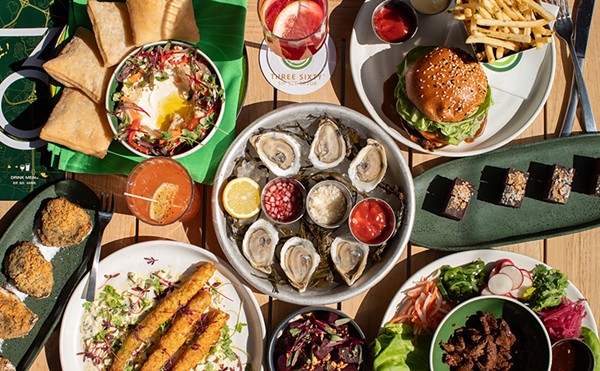Although "curry" derives from the Southern Indian word kari, meaning "sauce," the term applies loosely to a variety of savory, spicy dishes ranging from mellow Southeast Asian curries to piquant Indian curries to scorching Thai curries. For most Americans, though, the word calls to mind curry powder, a commercial blend of spices. The amalgam was concocted in the 19th century for Brits with a hankering for the curries they had enjoyed in India when that country was part of the British Empire. Turmeric, a yellow-orange root used in ballpark mustard, gives curry powder its characteristic golden hue, but the blend usually also contains coriander, cumin and mustard seeds, red and black pepper, fenugreek, cinnamon and cloves. The seeds are toasted to deepen their flavor; then the spices are finely ground.
Whether it's curry powder or the Essence of Emeril, though, sprinkling the same ready-made seasoning into every pan guarantees that one dish will taste like all the others. Instead, Indian cooks use masala, a freshly prepared spice mixture with infinite permutations. In the south of India, whole spices are pulverized on a grinding stone with water, lime juice, coconut milk or vinegar to make masala paste. In the north, masala is a dry blend of ground spices, the best known of which is garam masala, a biting belladonna of cinnamon, black pepper, cloves and black cardamom, sometimes blunted with tamer, more aromatic spices. Maharaja uses dry masala in many dishes, but chef Ohm Praksh doesn't distinguish among the variations, perhaps because punctuating each dish with distinct spices is second nature to him. The restaurant's chicken curry, for example, consists of boneless chunks of chicken suspended like corks in a tawny, gravylike sauce lashed with masala. It's served with peas pulav, saffron-scented basmati rice dotted with green peas. Basmati, which means "queen of the fragrance," is a nutty, long-grained rice that's aged to decrease its moisture content, giving it a toothsome chewiness. In India, diners knead the curry into the rice with the fingers of the right hand, but you can use a fork to do the mixing if you prefer.
Leavened bread, baked in a clay oven called a tandoor, has traditionally taken the place of utensils in ladling rice, vegetables and meat. Although we identify the kilnlike tandoor with Indian cuisine, it's used in Arab countries as well. Unlike European brick ovens, the tandoor is actually a piece of pottery, a beehive-shaped clay jar. Maharaja bakes bread, or naan, by slapping the sticky dough against the tandoor's lining. The heavy dough slides down the oven wall in the 500-degree heat, drooping into its characteristic teardrop shape. Tandoor meat cookery has been popular in India only since 1948, when the trend began at a Kashmiri restaurant frequented by New Delhi politicians. At Maharaja, seafood, chicken and lamb dishes are baked in the tandoor. The best of those we sampled was hariali tikka, ragged strips of white-meat chicken marinated in yogurt, masala and mint. The yogurt is invisible after cooking, but it moistens the poultry and gives it a subtle tang. Tandoori prawns were less appealing. They were actually medium-sized shrimp rather than prawns (an ambiguous term that usually refers to lobsterlike crustaceans about 6 inches long), and they had become elastic in the searing heat of the tandoor. A sampler platter of appetizers included boti kabab, marinated lamb tenderloin roasted in the tandoor. The cubes of lamb, charred and shriveled, were surprisingly tasteless. And because the restaurant doesn't serve alcohol, we didn't have the consolation of washing it all down with a few swigs of Taj Mahal beer.
Of course, Hindus, who follow a vegetarian diet, dominate India's population. Some South Asian vegetables aren't available here, but produce eaten in both countries includes green beans, peas, spinach, squash, potatoes, tomatoes and bell peppers. Samosas, fried pastries shaped like puffy tri-cornered hats, are filled with mashed potatoes, peas and chopped onions. They're as commonplace in India's cities as hot dogs are in Manhattan, peddled from carts by street-corner vendors. Maharaja offers the delicately spiced treat as an appetizer, and they're as habit-forming as curry. The restaurant's vegetarian entrées are pleasing, too. Nargese aloo is a peculiar yet satisfying dish of stuffed potatoes the size and shape of pingpong balls in a cloak of gravylike sauce perfumed with ginger and masala. The potato spheres somehow form shells around crumbly balls that taste similar to falafel. Mutter paneer, springy cubes of Indian cottage cheese blanketed in a plush sauce, is a simple, flavorful dish. The spongy cheese, which bears no resemblance to the cottage cheese we're familiar with, is made by curdling milk, compressing it and cutting it into cubes. Legumes -- such as chickpeas, yellow peas and pink, orange and red lentils -- are eaten throughout India. The word dal refers to split, peeled legumes (called "pulses" before the dried seed pairs are processed) or dishes made with them. But tasting Maharaja's dal makhani, black lentils in a lackluster sauce, was like taking a soporific after coming down from the punchy highs induced by the spicier dishes.
Legumes can also be ground into flour to make unique unleavened breads. When you arrive at Maharaja, your server will bring you a basket of papads, paper-thin, nutty-tasting wafers usually made with lentil and wheat flour. A chatty American teenager who was bussing tables, having misunderstood the word or perhaps just anglicizing it for our convenience, assured us that the tortillalike disks are called "poppers." The restaurant serves them with mint chutney (the English spelling of the Indian word chatni, a tangy relish or sauce that accompanies foods with neutral flavor) and tamarind chutney, a puckery-sweet, chestnut-colored sauce made from the dried pulp of pods from the exotic tamarind tree, sometimes called the Indian date.
Maharaja's space is an incongruous backdrop for such vibrant food. The building's façade looks as though it might house a quilt shop or a bed-and-breakfast. The serviceable dining room, with its forest-green carpet and fruit-bowl-patterned wallpaper border, could have been lifted out of a suburban split-level. The lack of a distinctive décor matters little, though, when the kitchen turns out food this intriguing, the spices so fragrant you can catch a whiff of them from two stoplights away -- after all, you can't say that about fish and chips.





